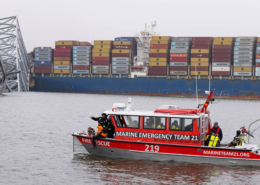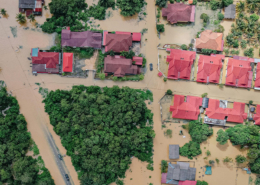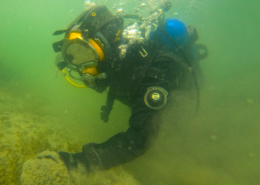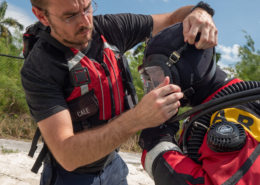Public Safety Diver Response to an Underwater Cave Drowning
by Wendell Nope
This is intended to be a follow-up to the excellent article submitted by Harry Averill in the January 2017 edition of the ERDI News, in which he introduced the Public Safety Diving community to the International Underwater Cave Rescue and Recovery organization (IUCRR).
As the commander of a Public Safety Diver Team, consider the following series of telephone calls:
1:30pm 911 Operator: “911 … what is your emergency?”
Caller: “My husband and a friend went diving in _____ Spring and haven’t
come back out. I’m very worried.”
911 Operator: “How long overdue are they, ma’am?”
Caller: “Two hours. They told me to call you if they didn’t come out by
1:30pm. They said it was just a safety precaution, but I’m
really-really worried.”
911 Operator: “OK, ma’am … I’m sending an officer there right now. Please stay
on the line so I can get some more information from you.”
1:32pm Dispatcher: “[Dive Team Leader via cell phone], we have a report of divers in the
______ spring who are two hours overdue from surfacing. Can you and
your Team respond?”
Team Leader: “You bet. We’ll be en route.”
1:33pm Team Leader: [Group Text] “Dive Team callout at ______ Spring. Respond ASAP.”
1:35pm Team Diver: “[Dive Team Leader], we don’t have anybody who is certified to dive
into that underwater passageway.
Team Leader: “I’ll make some calls and determine how to handle this. Head on over
there, we’ll figure it out when we get there.”
International Underwater Cave Rescue & Recovery
Whether it is an underwater cave system that empties into a spring-head, a flooded mine, or a man-made underwater culvert, a drowning in an overhead environment does indeed exceed the standard Public Safety Diver skill-set. The January 2017 ERDI News article entitled “The One Situation Public Safety Diver Training Does NOT Prepare You For” by Harry Averill covered this topic extensively and articulately. So, what is to be done when a deployment like the one above comes to your team. As Mr. Averill explained, the safest decision is to contact the International Underwater Cave Rescue & Recovery organization.
Nearly every State in the USA has a diveable underwater cave system of one type or another.
But EVERY State has culverts, flooded mines, or similar underwater passageways that could be described as man-made underwater caves. Additionally, it is not always a Cave Diver who loses his/her life in a cave … victims are often Open Water Divers who venture into an overhead environment. Some States, such as Florida, have had numerous incidents wherein the IUCRR has been utilized in this unique function. When contacting and utilizing IUCRR personnel there is well-established and has resulted in an almost 100% recovery rate. But, if you’re reading this and work in a State where there never to-date has been a need to employ IUCRR assets, you’re probably wondering about the practicality of using IUCRR and how they function. The remainder of this article is dedicated to you. For simplicity sake, I’ll use the State of Utah in this role-playing event. The incident will follow the elements of the original phone call above.
First, the Dive Team Leader who – by the way – remembered Harry Averill’s educational article, got on his cell phone, Googled “IUCRR” and got an immediate response of iucrr.org. The following web page showed up on his screen.
(This graphic is an actual screen capture of the IUCRR Main Web Page and may be accessed by Laptop, Tablet, or even Smart Phone.)
Upon arriving here, the Dive Team Leader notices two different links entitled “Emergency.” Either one will do. Upon clicking one of these links you will see the following web page.
(You now have several options … you can call one of the main numbers listed here or scroll down until you find somebody who coordinates your area.)
(If you scrolled down to see the Regional Coordinators, here is what you see.)
So, now as you are deciding who you’re going to call or email – wait a minute – you don’t have time to wait for an email … what gives? Each of the IUCRR Regional Coordinators have an email address that is forwarded to their cell phone. Whether you choose a phone call or email, your message will reach the Regional Coordinator at the same time. Another thought pops into your head: “I know less about these people than I do about Cave Diving. What is it they do? How do they perform the recovery? What credentials do they have? I need detailed documentation of the recovery. What am I about to get myself into?”
To answer those questions, let’s transition from how to make contact with the IUCRR and explore more about what they do and how they operate. As mentioned in the original article, the IUCRR was created by Lt. Henry Nicholson of the Jacksonville Sheriff’s Office in northeast Florida, to develop an efficient response to the unique elements of a diver dying in an overhead environment. In fact, the idea of the IUCRR developed when Lt. Nicholson and several other Public Safety Divers were conducting a black-water search in the St. Johns River and began to surface, only to find that a huge barge had parked itself above them, creating an overhead environment. Luckily, everyone found their way out to open water that day. Further, the IUCRR follows standard law enforcement practices in its recovery procedures, documentation, and report writing. When proper procedures are followed, no action or procedure enacted by an IUCRR Diver would violate the principles of a standard law enforcement homicide investigation, when proper procedures are followed. Lt. Nicholson created IUCRR protocols that could withstand the scrutiny of court litigation. These protocols have already survived numerous litigations, primarily because they were created by a veteran law enforcement officer. Finally, in order to stay appraised on the latest legal issues and investigative procedures, the IUCRR maintains a Law Enforcement Officer Board (LEOB) of career officers who function as technical advisors.
Well, how does an IUCRR Diver train and perform? Quite simply, the training is comparable to that which every competent investigator learns when s/he begins a homicide investigation school. It is a prerequisite to be a Full Cave Diver to enroll in IUCRR training. The initial IUCRR training is conducted in a classroom such as may be seen in the accompanying photograph. Investigative procedures, report writing, legal issues, hazards, etc. must be internalized by the would-be IUCRR Divers. The Instructor in this photograph is Mr. Lamar Hires, Head Trainer for the IUCRR. He has successfully coordinated numerous Cave Diver recovery efforts under the umbrella of local jurisdictions in Florida. Notice that one of the students is wearing a Columbia County Fire Department shirt. He is an example of a Public Safety Diver who is also a Cave Diver, and is now learning to be an IUCRR Diver. There are actually quite a few PSD Divers across the USA who are also Cave Divers and then become IUCRR Divers.
Once the academic phase of the training is done, the remainder of IUCRR Diver training is “Reality-Based,” meaning that it is conducted on-site and is hands-on. Divers are trained via a series of Cave Diver drowning simulations, such as is represented in the following photograph. Note that the IUCRR Diver-to-be is in this photo is documenting critical information such as body position, gear configuration, gas pressures, and numerous other critical data. Photographs and video of the victim are standard procedures.
An amazing amount of data is documented before the victim’s body is moved from its pristine position. Photographs and video provide excellent evidence, when visibility permits. When the water is crystal clear as in this particular cave, very informative photos and videos can be acquired. But, it is not always so. Occasionally, silt conditions created by the victim diver prevent high quality or detailed images or video. In such a situation, recovery is still feasible, just not easily documented.
Nevertheless, this article is meant to be educational and informative, so let’s view some video footage taken in optimal water conditions. This will show just how much data can be acquired when videography is possible.
Video #1 represents the first IUCRR dive, which usually consists of the discovery phase and occasionally also the documentation phase. Of course, the dive objectives would first be established by the homicide investigator, but often the cave portion of the recovery is turned over to the IUCRR personnel. As shown, the diver(s) first locates, then performs a 360 degree video sweep around the victim. This particular segment represents a discovery, a cursory video, and a return to the homicide investigator to decide a formal documentation and recovery strategy. It is not uncommon to require multiple dives to achieve the complete recovery process. Occasionally, after a proper documentation dive, gear must be removed from the victim on the next dive in order to make a safe extraction … then a final dive is made to extract the victim’s gear. In a State with numerous IUCRR divers, such as Florida, each dive may be performed by a different set of divers. It is also possible for one set of divers to conduct all dives, however, this may require more than one day to complete if the victim is far back in the cave, stuck in a tight restriction, or some other challenging situation exists.
Video #1 https://www.wendellnope.com/iucrr-discovery-dive.wmv
Video #2 represents a training exercise in which the victim documentation dive is shown. Each diver documents pertinent information while the victim is still in a pristine situation. Once all the pertinent data is collected, the extraction phase may begin or may be enacted by another set of divers. Notice the video diver documents not only the victim, but also the documentation taking place. In this simulation, the videography adds compelling evidence of the recovery procedure.
Video #2 https://www.wendellnope.com/iucrr-document-dive.wmv
Video #3 represents a training exercise in which a victim is extracted from the cave. Here, you can easily observe the “mule” and “driver” aspect of this phase of the mission. The “mule” provides the primary propulsion and the “driver” guides the victim’s body through the cave passage. The “driver” can also provide propulsion when possible. This procedure is well-established, meant to increase efficiency, and most of all … diminish the risk of a “silt-out” in the cave. Cave diving is dangerous enough as it is, much less when an extraction is necessary. This video segment covers a short distance extraction, yet the concepts and procedures are clear. The IUCRR divers can bring the victim all the way to the surface/shore/dock or may be met at the mouth of the cave (in open water) by the local Public Safety Divers if the homicide investigator so desires. Although the divers in this video are just learning the extraction procedures, their performance is nonetheless commendable. Notice the “driver” taking great care throughout the extraction to reduce the possibility of the victim getting unduly scraped. For the sake of time, the decompression stop at the mouth of the cave has been edited out of this video. FYI, this is a rather large-size video, so it may take a minute or more to download, according to your internet speed.
Video #3 https://www.wendellnope.com/iucrr-extract-dive.wmv
As a Public Safety Diver, you have developed many skills.
A Cave Diver also acquires many skills. But, neither a Public Safety Diver nor a Cave Diver have sufficient skill to conduct a safe recovery of a diving fatality in an overhead environment. Specific training as an IUCRR is necessary to prevent a possible secondary casualty of the recovery diver(s). No IUCRR Diver has ever died during a recovery of a diver in an overhead environment. You may now intelligently understand that a diver fatality in a cave, culvert, or other overhead environment is an incident in which a specialized Responder is necessary. Now, you know who to call, why to call them, and what to expect from them. Safe diving.
Wendell Nope is a Sergeant with the Utah Department of Public Safety Dive Team and functions as Team Trainer. He is an ERDI Instructor, Full Cave Diver, IUCRR Diver, and is also the Utah IUCRR Regional Coordinator. The Utah DPS Dive Team website is https://dive.utah.gov and his personal website ishttps://www.wendellnope.com, at which numerous Public Safety Diving and Cave Diving videos may be perused. Wendell may be contacted at his official email address wnope@utah.gov or his official cell phone 801-209-5790.







 Photo By: Defense Visual Information Distribution Service
Photo By: Defense Visual Information Distribution Service


 Y. ZIN
Y. ZIN


השאירו תגובה
רוצה להצטרף לדיון?תרגישו חופשי לתרום!